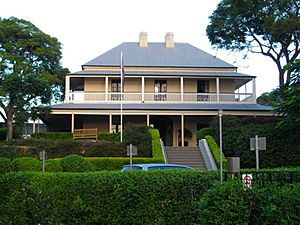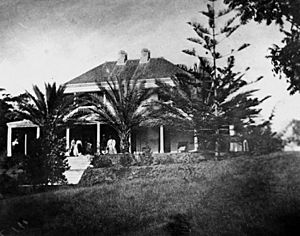Milton House, Milton facts for kids
Quick facts for kids Milton House |
|
|---|---|

Milton House, 2009
|
|
| Location | 50 McDougall Street, Milton, City of Brisbane, Queensland, Australia |
| Design period | 1840s–1860s (mid-19th century) |
| Built | c. 1852 – 1922 |
| Architectural style(s) | Colonial Georgian |
| Official name: Milton House | |
| Type | state heritage (built) |
| Designated | 21 October 1992 |
| Reference no. | 600253 |
| Significant period | 1850s-1860s, 1920s (fabric) 1850s-1880s |
| Significant components | residential accommodation – main house, views from, cellar, views to |
| Lua error in Module:Location_map at line 420: attempt to index field 'wikibase' (a nil value). | |
Milton House is a very old and special house located at 50 McDougall Street in Milton, a suburb of Brisbane, Queensland, Australia. It was built around 1852. This historic home is now listed on the Queensland Heritage Register, which means it's protected because of its important history and design.
Contents
The Story of Milton House
Early Days and Cotton Farming
Milton House was built in 1852 or 1853 for a retired chemist named Ambrose Eldridge. He used to own a chemist shop on Queen Street in Brisbane. This house was the first big home in the area and quickly became a well-known landmark. You could see it clearly in early pictures of Brisbane!
Ambrose Eldridge was a chemist from Sydney who arrived in Brisbane in 1847. He bought a chemist shop in 1849. In the 1840s and 1850s, Eldridge was very active in helping Brisbane and Queensland grow. He supported the idea of Queensland becoming its own colony, separate from New South Wales. He also joined many local groups that helped develop the area.
Eldridge was a respected person who truly wanted Brisbane to succeed. He had a big idea: he wanted to prove that farming in the Moreton Bay area (which is now Queensland) could make money.
In 1851, Eldridge bought over 30 acres of land along the Brisbane River. He called this land Milton Farm. Here, he started experimenting with cotton growing. He hoped to show that farming cotton could be profitable in this region. Cotton was a very important product for Great Britain's factories at the time. If it grew well here, it would help the area become rich and independent.
By September 1852, five acres of the Milton land were ready. The next month, Eldridge planted seeds for a special type of cotton called Sea Island Cotton. At the end of 1852, he stopped working as a chemist to focus completely on his Milton Farm experiment. This is probably when Milton House was built.
By June 1853, the first cotton crop was ready to be picked. Eldridge reported that he made a profit from his first harvest! That December, he won a prize of £30 from the New South Wales Government for his cotton samples. Two years later, he sent his Milton cotton to the Paris Exhibition of 1855, where it received high praise.
New Owners and the Suburb's Name
In 1853, Eldridge tried to expand his farming efforts by leasing a large area of land at Eagle Farm. By 1855, he decided to move there and sell Milton Estate. The property, including the large house, was sold to a pastoralist (someone who owns large areas of land for grazing animals) named John Frederick McDougall in January 1856.
Unfortunately, Eldridge's farming experiments at Eagle Farm didn't work out. He returned to being a chemist in 1859 and passed away in 1860, leaving his family without money.
John Frederick McDougall was an important person; he was a member of Queensland's first parliament. He continued to farm the Milton Estate and made the house much bigger. After 1864, the McDougalls lived at another property and rented out Milton House. Many important people lived there as tenants. The house became so well-known that it gave its name to the local suburb of Milton! The nearby suburb of Rosalie was named after one of McDougall's other properties, showing how much land he once owned in the area.
In 1885, Milton Farm was sold again and divided into smaller blocks for homes. This is when new streets like McDougall, Manning, Walsh, and Crombie were created, named after the people who had owned or lived in Milton House.
Later, in 1887, the Commissioner of Police, David Thompson Seymour, bought nearly two acres of land, including the house. He sold it the next year to Dr. Hugh Bell, a famous doctor. In 1904, the Siemon family bought the property and renovated it in 1922.
In 1955, the Siemon family gave Milton House to the Presbyterian Church. The church used it as a hostel (a place for students to live) for women college students until 1983. After that, the building became part of a modern office park development. It was carefully restored to look like it did in the 1860s.
What Milton House Looks Like
Milton House has a special design called Colonial Georgian style. It has a hip roof, which means all sides slope downwards to the walls. The front doorway is typical of this style, with small windows on the sides and an arched window above the door. Inside, the rooms are arranged symmetrically around a central hallway on each floor.
The ground floor has wide, open verandahs on three sides, which are like covered porches. The walls are made of brick, but they are covered with a special plaster that makes them look like stone. There's also a three-roomed cellar (an underground room) made of rough stone, which you can enter by steps from the verandah. The original roof shingles have been replaced with corrugated iron.
Inside, the narrow staircase is made of cedar wood. The entrance hall has a fancy plaster ceiling. The dining room has a special metal ceiling from the early 1900s. The first floor used to have bedrooms and also has narrow verandahs on three sides. You can get to these verandahs through French doors. There are fireplaces in the ground floor rooms, but the ones upstairs have been closed off. These fireplaces lead to tall chimneys that stand out on the roof.
Milton House was originally built on a high spot overlooking the river. Old photos from the 1860s show palm trees and a path leading down to the river. Today, the garden has new plants, but it still has old poinciana and jacaranda trees. The back of the house now has a tennis court, swimming pool, and outdoor area. You can still catch a glimpse of the house from Coronation Drive, even with modern office buildings around it.
Why Milton House is Important
Milton House was added to the Queensland Heritage Register on 21 October 1992. This means it's considered a very important historical site for several reasons:
- It shows how Queensland grew: Milton House is important because it's linked to early farming experiments in Queensland before it became its own colony. It also shows how the western suburbs developed before more people moved in during the 1860s. It's one of the oldest surviving houses in Brisbane and was the first big house in the western suburbs.
- It's a rare example: Milton House is one of the few houses left in Brisbane that was built before Queensland separated from New South Wales. It's a rare example of the 1850s Colonial Georgian style of architecture in Brisbane.
- It shows a special type of architecture: The house still has its original shape, features, and materials. It's a great example of Colonial Georgian architecture that was changed to suit the local weather, especially with its verandahs and French doors on three sides.
- It has a special connection to the community: Milton House is very important to the local community. The house actually gave its name to the suburb of Milton! The nearby suburb of Rosalie also reminds us of John Frederick McDougall, who owned Milton House for a long time. It was an early landmark that people could see from the main road along the river.


